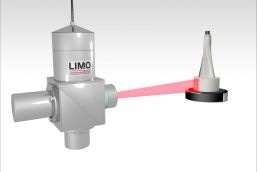Laser transmission welding of fiber-reinforced thermoplastics aids lightweight automobile construction
September 16, 2016

Fiber-reinforced thermoplastics coupled with the use of laser transmission welding are opening up entirely new possibilities of functionalization and design in lightweight automobile construction according to German firm LIMO Lissotschenko Mikrooptik GmbH (Dortmund). The company recently developed an extremely compact laser processing head capable of reducing processing costs by up to 30% and enabling the processing of parts previously considered too complex.
Laser polymer welding is said to be an industry-compatible and product-friendly bonding technology that produces tough yet aesthetically pleasing weld seams. Processing is clean and contactless. The bonding surface does not have to be pre-cleaned, post-cured or processed in any way. It is particularly suited for sensitive materials, for optically demanding surfaces, for very precise weld seams or for very short cycle times. Containers manufactured using laser welding (e.g. to hold fluids or to house sensors) display a very high density, with a burst pressure of 10-30 bar. Electronic parts are not impaired by the welding process. Furthermore, diverse combinations of materials can be processed, such as acrylic and acrylonitrile-butadiene-styrene (PMMA/ABS), polycarbonate and polybutylene terephthalate (PC/PBT), polypropylene and thermplastic elastomer (PP/TPE), as well as glass fiber-reinforced polymers.
The LPH-L laser processing head reportedly offers a unique combination of five features: newly designed, the LPH-L processing head is less complex and can reduce processing costs by up to 30% in comparison to similar systems; measuring just 153 x 90 mm, it is up to 50% more compact than comparable processing heads; four welding geometries are possible using a single multifunctional laser head (spot welding, surface welding, contour welding, and continuous material bonding). Thus, the LPH-L head offers a wide range of welding options without the need for implementing scanner technology; temperature-regulated processing and data logging are already integrated into the laser system; and weighing only 1.2 kg, the compact and robust head can be deployed on lightweight robot arms;
Peter Bruns, Director Application and Customer Service at LIMO, summarizes the advantages of the new head as follows: “With LIMO’s new compact line processing head, suppliers of lightweight automobile components can now serve the middle and low-cost market segments as well as the high-end segment.”
Together with a fiber-coupled industrial laser system, the compact processing head LPH-L processing head can generate a 12 x 2 mm welding line. By rotating the processing head, the welding line can be adjusted to a minimum length of 5 mm. Further, by mounting the head on a robot arm, it is possible to achieve diverse welding geometries using only one tool. In addition, the processing head is able to compensate for level differences in the component of up to 12 mm.
The LPH-L head also allows welding spots to be applied in the form of short lines of around 10 mm. These “line-spots” are more strain-resistant than standard spots. The laser head is also able to weld a surface of 12 x X mm, where “X” denotes a variable surface size. In this way surfaces are more quickly bonded than is possible with, for example, a laser scanner. The system can also create a third beam geometry, namely a contour weld of width 5-12 mm.
Applied to continuous material in a roll-to-roll process, the laser beam head can also generate a continuous weld seam. This also highlights the advantage of gentler linear welding: Heat is generated more slowly along the line (linear intensity distribution) than in the case of laser spot welding. At the same time, the strength of the weld is not impaired. The advantage: heat-sensitive materials or components are not distressed by the welding process.
The new laser beam head allows the processing of large as well as small and fragile components such as membranes, opening up new possibilities in design and functionalization. The processing head can be integrated into the manufacturing process inline and can be deployed on a robot arm. The welding process is monitored by an integrated measurement and control system. Processing data are stored to enable track and trace.
LIMO has vast experience in laser welding for car bodies and components encompassing for more than 40 different assembly groups in the car interior, exterior, the cockpit, under-the-hood parts, lighting elements, etc. LIMO’s industrial laser systems have also been successfully utilized in the medical and electronics sectors.
You May Also Like


